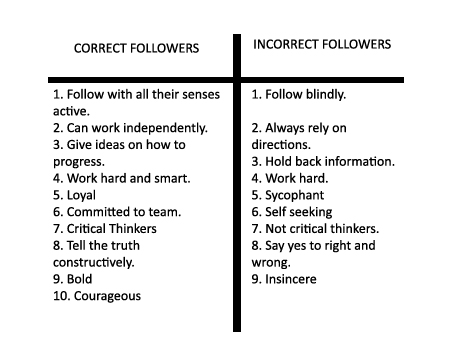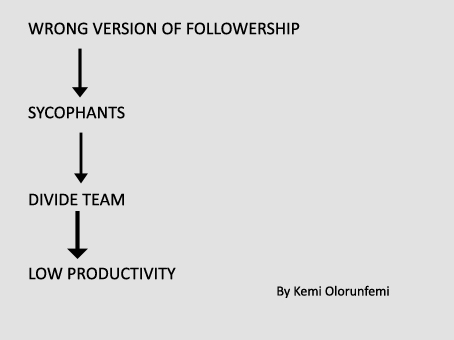Leadership – What to do when your Leader is your Dad.
Leadership – What to do when your Leader is your Dad.
In order to achieve maximum effectiveness and productivity, there is need to strategise and cultivate certain enabling culture for minimum friction, when your Leader happens to be your Dad.
The following points are needful on how to cope when your Leader is your Dad:
- Accept that your Dad is your Leader at work and submit to his leadership.
- Remember that he is your employer and give him his rightful place.
- Be humble before him and other team members.
- Get to the office on time.
- Obey the office rules and be subject to facing the consequences of breaking rules just like other team members.
- Try not to correct him openly, especially in front of other team members.
- Correct constructively and do not over react.
- Dress corporately or neatly to fit your work.
- Close from work at the correct time. Avoid closing at 2pm when the stipulated closing time is 4pm.
10.Listen to understand, when he has something to say. Then
contribute your own points intelligently.
- Enhance your skills to be competent and relevant at work.
- Familiarity should come up when you get back home, not in
the office. Spend time together as father and son or friends outside office hours.
- Be subject to the hierarchy of the organization like any other
Staff.
- Work as a team with others.
- Study how your Leader works and find creative ways to do it
better and more effectively.
- Be accessible as much as possible.
- Stay on your own duties.
- Do not boss your Leader because he is your Dad.
- Avoid being his rival at work.
- Be polite to all and just find ways to enjoy the work.
When the Leader (your Dad) , sees that you carry yourself well, you will gain his respect, trust and even get promoted. When you talk, he is likely to listen and there will be less friction.
Pirate Admiral
Wow!
Leadership – Followership is not sycophancy.
Dictionary.com describes sycophant as a person who tries to win favour from wealthy or influential people by flattering them.
Cambridge English Dictionary says sycophant is a person praising people in authority in a way that is not sincere, usually to gain some advantage.
Then Merriam Webster says that a sycophant is a servile self seeking flatterer.
Followership as defined by free encyclopaedia is the capacity of an individual to actively follow a leader. It also says that it is the reciprocal social process of leadership.
Everybody is a follower of somebody. Therefore leaders need to develop themselves in the area of followership. This will enhance their empathic sense. Leaders need to know how to choose and relate to followers for maximum impact and productivity.
Without followers there will be no leaders. Followers are the ones who actually do the work. For instance, a lot of people do not know the overall leader of CNN which is a media outfit but they know the reporters and a lot of the staff. Followers are doing a great job. The success of leaders is largely dependent on followers. Where the followers are not competent, the leaders will most likely record low effectiveness.
Somebody who has never followed anybody in a particular field may not lead well in that field. This is because by following somebody, you get to learn what to do and what not to do to followers.
The way a leader communicates either through behaviour or speech shapes the commitment of followers. Thus, leaders need to cultivate attitudes that will bring the best out of their followers. This makes communication to flow unhindered from followers to leaders and from leaders to followers.
Leaders should know the difference between followers and sycophants which is the wrong version of followership. Sycophants can divide an organization to an unhealthy point. Sycophants are everywhere and even with sycophantic laughter or nodding of head. In the church and in the secular, they are just everywhere with accolades for leaders. They are self seeking flatterers who say the leader is right even when wrong. Good leaders need to have genuine, correct, current and bold followers.
Listed below are the differences between correct and incorrect followers.
Leadership and Consistency.
Consistency is about lack of deviations. An organization can crash without consistency. It is about standing by your words. It is about finishing something when you start. It takes a level of grace to start but takes another level of grace to finish.
When a leader agrees to be at a meeting or somewhere at a particular time, then be there and if you can not be there at that time, then let the people involved be informed of the new development.
Great and good leaders most of the time keep to their promises. Unfulfilled promises breed inconsistency which results in lack of trust from team members or followers. It is difficult to believe leaders who are not consistent in following up promises.
Inconsistency turns followers to doubters and establishes a leaders reputation.
The tendency is that when the leader is inconsistent, the followers get to be inconsistent too. This is because leadership should be by example. It is do as I do not do as I say.
lack of consistency leads to frequent deviations that can cause staff turnover. These staff could be the major quality team members of the organization.
Leadership requires consistency for high performance and to build good reputation.
HELP TO BE CONSISTENT INCLUDE:
1. Set deadlines for progress reports.
2. Set reminders for appointments.
3. Practice humility.
4. Consistency does not mean you can not make changes. It only needs you to inform other players on time when changes occur which should not be frequent, so that they can plan their time well.
5. Ask yourself certain question. Such as:
A. Are the projects that I have started still pending, abandoned or completed?
B. Do I follow up on my promises?





